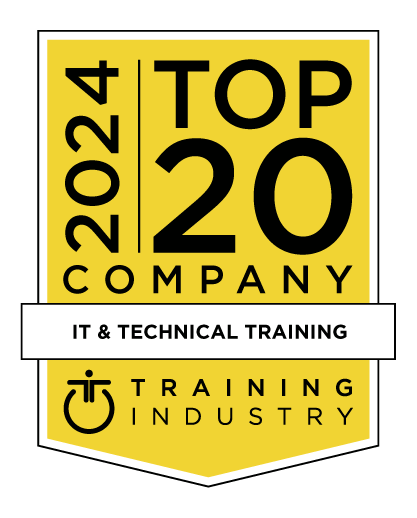title
Please take a moment to fill out this form. We will get back to you as soon as possible.
All fields marked with an asterisk (*) are mandatory.
Microsoft Azure Administrator
Course Description
Overview
This course teaches IT Professionals how to manage their Azure subscriptions, secure identities, administer the infrastructure, configure virtual networking, connect Azure and on-premises sites, manage network traffic, implement storage solutions, create and scale virtual machines, implement web apps and containers, back up and share data, and monitor your solution.Objectives
Audience
- Understanding of on-premises virtualization technologies, including: VMs, virtual networking, and virtual hard disks.
- Understanding of network configurations, including TCP/IP, Domain Name System (DNS), virtual private networks (VPNs), firewalls, and encryption technologies.
- Understanding of Active Directory concepts, including users, groups, and role-based access control.
- Understanding of resilience and disaster recovery, including backup and restore operations.
Prerequisites
-
Successful Azure Administrators start this role with experience in virtualization, networking, identity, and storage.
- Understanding of on-premises virtualization technologies, including: VMs, virtual networking, and virtual hard disks.
- Understanding of network configurations, including TCP/IP, Domain Name System (DNS), virtual private networks (VPNs), firewalls, and encryption technologies.
- Understanding of Active Directory concepts, including users, groups, and role-based access control.
- Understanding of resilience and disaster recovery, including backup and restore operations.
- Microsoft Azure Fundamentals: Describe cloud concepts
- Azure Fundamentals: Describe Azure architecture and services
- Azure Fundamentals: Describe Azure management and governance
- AZ-104: Prerequisites for Azure administrators - Learn | Microsoft Docs
Topics
- Use Azure Resource Manager
- Introduction
- Review Azure Resource Manager benefits
- Review Azure resource terminology
- Create resource groups
- Create Azure Resource Manager locks
- Reorganize Azure resources
- Remove resources and resource groups
- Determine resource limits
- Introduction
- Azure management options
- Navigate the portal
- Exercise - Work with resources
- Exercise - Use the Azure portal
- Azure portal dashboards
- Exercise - Customize the dashboard
- Access preview features
- Introduction
- What is Azure Cloud Shell?
- How does Azure Cloud Shell work?
- When should you use Azure Cloud Shell?
- Introduction
- What is Bash?
- Bash fundamentals
- Bash commands and operators
- Exercise - Try Bash
- Exercise - Terminate a misbehaving process
- Exercise - Use Bash and grep to filter CLI output
- Introduction
- What is PowerShell?
- Exercise - Run your first PowerShell commands
- Locate commands
- Exercise - Locate commands
- Introduction
- Explore Azure Resource Manager template structure
- Exercise - Create and deploy an Azure Resource Manager template
- Add flexibility to your Azure Resource Manager template by using parameters and outputs
- Exercise - Add parameters and outputs to your Azure Resource Manager template
- Module assessment
- Introduction
- Examine Microsoft Entra ID
- Compare Microsoft Entra ID and Active Directory Domain Services
- Examine Microsoft Entra ID as a directory service for cloud apps
- Compare Microsoft Entra ID P1 and P2 plans
- Examine Microsoft Entra Domain Services
- Introduction
- Create, configure, and manage users
- Exercise - assign licenses to users
- Exercise - restore or remove deleted users
- Create, configure, and manage groups
- Exercise - add groups in Microsoft Entra ID
- Configure and manage device registration
- Manage licenses
- Exercise - change group license assignments
- Exercise - change user license assignments
- Create custom security attributes
- Explore automatic user creation
- Module assessment
- Introduction
- What is Microsoft Azure
- Get started with Azure accounts
- Exercise - Explore the Learn sandbox
- Describe Azure physical infrastructure
- Describe Azure management infrastructure
- Exercise - Create an Azure resource
- Module assessment
- Introduction
- Cloud Adoption Framework for Azure
- Azure Policy design principles
- Azure Policy resources
- Azure Policy definitions
- Evaluation of resources through Azure Policy
- Check your knowledge
- Introduction
- What is Azure RBAC?
- Knowledge check - What is Azure RBAC?
- Exercise - List access using Azure RBAC and the Azure portal
- Exercise - Grant access using Azure RBAC and the Azure portal
- Exercise - View activity logs for Azure RBAC changes
- Knowledge check - Using Azure RBAC
- Introduction
- What is self-service password reset in Microsoft Entra ID?
- Implement Microsoft Entra self-service password reset
- Exercise - Set up self-service password reset
- Exercise - Customize directory branding
- Summary
- Introduction
- Plan virtual networks
- Create subnets
- Create virtual networks
- Plan IP addressing
- Create public IP addressing
- Associate public IP addresses
- Allocate or assign private IP addresses
- Interactive lab simulation
- Introduction
- Implement network security groups
- Determine network security group rules
- Determine network security group effective rules
- Create network security group rules
- Implement application security groups
- Interactive lab simulation
- Knowledge check
- Summary and resources
- Introduction
- Determine Azure Virtual Network peering uses
- Determine gateway transit and connectivity
- Create virtual network peering
- Extend peering with user-defined routes and service chaining
- Interactive lab simulation
- Introduction
- Review system routes
- Identify user-defined routes
- Determine service endpoint uses
- Determine service endpoint services
- Identify private link uses
- Interactive lab simulation
- Introduction
- Determine Azure Load Balancer uses
- Implement a public load balancer
- Implement an internal load balancer
- Determine load balancer SKUs
- Create back-end pools
- Create health probes
- Create load balancer rules
- Interactive lab simulation
- Introduction
- Implement Azure Application Gateway
- Determine Azure Application Gateway routing
- Configure Azure Application Gateway components
- Introduction
- Network IP addressing and integration
- Public and private IP addressing in Azure
- Plan IP addressing for your networks
- Exercise - Design and implement IP addressing for Azure virtual networks
- Introduction
- Connect services by using virtual network peering
- Exercise - Prepare virtual networks for peering by using Azure CLI commands
- Exercise - Configure virtual network peering connections by using Azure CLI commands
- Exercise - Verify virtual network peering by using SSH between Azure virtual machines
- Introduction
- What is Azure DNS?
- Configure Azure DNS to host your domain
- Exercise - Create a DNS zone and an A record by using Azure DNS
- Dynamically resolve resource name by using alias record
- Exercise - Create alias records for Azure DNS
- Introduction
- Identify routing capabilities of an Azure virtual network
- Exercise - Create custom routes
- What is an NVA?
- Exercise - Create an NVA and virtual machines
- Exercise - Route traffic through the NVA
- Introduction
- Azure Load Balancer features and capabilities
- Configure a public load balancer
- Exercise - Configure a public load balancer
- Internal load balancer
- Summary
- Introduction
- Implement Azure Storage
- Explore Azure Storage services
- Determine storage account types
- Determine replication strategies
- Access storage
- Secure storage endpoints
- Introduction
- Implement Azure Blob Storage
- Create blob containers
- Assign blob access tiers
- Add blob lifecycle management rules
- Determine blob object replication
- Upload blobs
- Determine Blob Storage pricing
- Interactive lab simulation
- Introduction
- Review Azure Storage security strategies
- Create shared access signatures
- Identify URI and SAS parameters
- Determine Azure Storage encryption
- Create customer-managed keys
- Apply Azure Storage security best practices
- Interactive lab simulation
- Introduction
- Compare storage for file shares and blob data
- Manage Azure file shares
- Create file share snapshots
- Implement soft delete for Azure Files
- Use Azure Storage Explorer
- Deploy Azure File Sync
- Introduction
- Decide how many storage accounts you need
- Choose your account settings
- Choose an account creation tool
- Exercise - Create a storage account using the Azure portal
- Knowledge check - Create a storage account
- Introduction
- Authorization options for Azure Storage
- Use shared access signatures to delegate access to Azure Storage
- Exercise - Use shared access signatures to delegate access to Azure Storage
- Use stored access policies to delegate access to Azure Storage
- Exercise - Use stored access policies to delegate access to Azure Storage
- Introduction
- Connect Azure Storage Explorer to a storage account
- Exercise - Connect Azure Storage Explorer to a storage account
- Connect Azure Storage Explorer to Azure Data Lake Storage
- Exercise - Connect Azure Storage Explorer to Azure Data Lake Storage
- Introduction
- Review cloud services responsibilities
- Plan virtual machines
- Determine virtual machine sizing
- Determine virtual machine storage
- Create virtual machines in the Azure portal
- Connect to virtual machines
- Interactive lab simulation
- Introduction
- Plan for maintenance and downtime
- Create availability sets
- Review update domains and fault domains
- Review availability zones
- Compare vertical and horizontal scaling
- Implement Azure Virtual Machine Scale Sets
- Create Virtual Machine Scale Sets
- Implement autoscale
- Configure autoscale
- Interactive lab simulation
- Knowledge check
- Introduction
- Implement Azure App Service plans
- Determine Azure App Service plan pricing
- Scale up and scale out Azure App Service
- Configure Azure App Service autoscale
- Knowledge check
- Introduction
- Implement Azure App Service
- Create an app with App Service
- Explore continuous integration and deployment
- Create deployment slots
- Add deployment slots
- Secure your App Service app
- Create custom domain names
- Back up and restore your App Service app
- Use Azure Application Insights
- Interactive lab simulation
- Introduction
- Compare containers to virtual machines
- Review Azure Container Instances
- Implement container groups
- Review Azure Container Apps
- Interactive lab simulation
- Knowledge check
- What is the Azure CLI?
- Exercise - Create a virtual machine
- Exercise - Test your new virtual machine
- Exercise - Explore other VM images
- Exercise - Sizing VMs properly
- Exercise - Query system and runtime information about the VM
- Exercise - Start and stop your VM with the Azure CLI
- Exercise - Install software on your VM
- Summary and cleanup
- Introduction
- Create a Windows virtual machine in Azure
- Exercise - Create a Windows virtual machine
- Use RDP to connect to Windows Azure virtual machines
- Exercise - Connect to a Windows virtual machine using RDP
- Configure Azure virtual machine network settings
- Summary
- Introduction
- Create a web app in the Azure portal
- Exercise - Create a web app in the Azure portal
- Prepare the web application code
- Exercise - Write code to implement a web application
- Deploy code to App Service
- Exercise - Deploy your code to App Service
- Summary
- Introduction
- What is Azure Backup?
- How Azure Backup works
- When to use Azure Backup
- Knowledge check
- Introduction
- Explore options to protect virtual machine data
- Create virtual machine snapshots in Azure Backup
- Set up Azure Recovery Services vault backup options
- Back up your virtual machines
- Restore your virtual machines
- Implement soft delete for your virtual machines
- Implement Azure Site Recovery
- Interactive lab simulation
- Knowledge check
- Introduction
- Describe Azure Monitor key capabilities
- Describe Azure Monitor components
- Define metrics and logs
- Identify monitoring data and tiers
- Describe activity log events
- Query the activity log
- Interactive lab simulation
- Knowledge check
- Introduction
- Determine Log Analytics uses
- Create a Log Analytics workspace
- Create Kusto queries
- Structure Log Analytics queries
- Knowledge check
- Summary and resources
- Introduction
- Describe Azure Network Watcher features
- Review IP flow verify diagnostics
- Review next hop diagnostics
- Visualize the network topology
- Knowledge check
- Summary and resources
- Introduction
- Explore the different alert types that Azure Monitor supports
- Use metric alerts for alerts about performance issues in your Azure environment
- Exercise - Use metric alerts to alert on performance issues in your Azure environment
- Use log search alerts to alert on events in your application
- Use activity log alerts to alert on events within your Azure infrastructure
- Use action groups and alert processing rules to send notifications when an alert is fired
- Exercise -Use an activity log alert and an action group to notify users about events in your Azure infrastructure
- Summary
- Introduction
- Features of Azure Monitor logs
- Create basic Azure Monitor log queries to extract information from log data
- Exercise - Create basic Azure Monitor log queries to extract information from log data
- Summary
- Introduction
- Monitoring for Azure VMs
- Monitor VM host data
- Use Metrics Explorer to view detailed host metrics
- Collect client performance counters by using VM insights
- Collect VM client event logs
- Summary
Related Courses
-
Microsoft Azure Security Technologies
MOC-AZ-500T00- Duration: 4 Days
- Delivery Format: Classroom Training, Online Training
- Price: 2,380.00 USD
-
Introduction to Microsoft Azure
MOC-AZ-900T00- Duration: 1 Day
- Delivery Format: Classroom Training, Online Training
- Price: 595.00 USD
Self-Paced Training Info
Learn at your own pace with anytime, anywhere training
- Same in-demand topics as instructor-led public and private classes.
- Standalone learning or supplemental reinforcement.
- e-Learning content varies by course and technology.
- View the Self-Paced version of this outline and what is included in the SPVC course.
- Learn more about e-Learning
Course Added To Shopping Cart
bla
bla
bla
bla
bla
bla
Self-Paced Training Terms & Conditions
Exam Terms & Conditions
ONCE YOU PURCHASE THIS EXAM YOU WILL NOT BE ABLE TO CANCEL YOUR ORDER. You are billed for the course after hitting submit. Exams are non-refundable.
Vouchers expire 12 months from the date they are issued, unless otherwise specified in the terms and conditions. Voucher expiration dates cannot be extended. All sales are final.Please refer to the full terms and conditions here.
Sorry, there are no classes that meet your criteria.
Please contact us to schedule a class.

STOP! Before You Leave
Save 0% on this course!
Take advantage of our online-only offer & save 0% on any course !
Promo Code skip0 will be applied to your registration
Purchase Information
title
Please take a moment to fill out this form. We will get back to you as soon as possible.
All fields marked with an asterisk (*) are mandatory.










